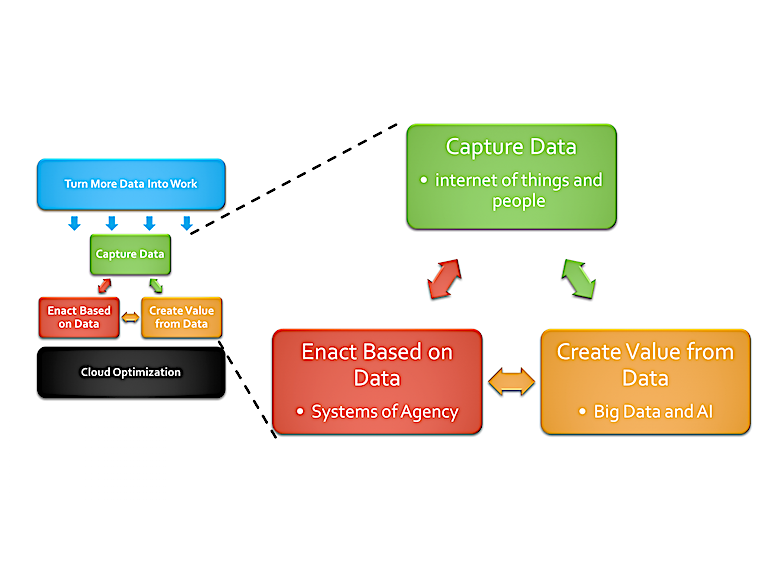Digital business depends on organizations’ ability to turn more data into more useful work. The principal enablers in that regard are enterprise investments in advanced analytics, artificial intelligence, deep learning and machine learning.
On Dec. 15, Wikibon held its annual webcast in which we predicted how the data analytics market, platforms, tools and practices are likely to evolve in the year to come. From that webcast, here are principal predictions from George Gilbert, Neil Raden and me:
- AI will become the backbone of high-performance IT operations and application management environments. ML is essential for continuous monitoring, optimization, diagnostics and remediation of today’s increasingly complex distributed computing environments. Gilbert predicted that, in 2018, information technology operations and application performance management will become the first high-volume, horizontal application of machine learning.
- Data-driven autoprogramming will become a centerpiece of enterprise application development. I predicted that, by year-end 2018, the latest autoprogramming techniques – including ML and robotic process automation – will be incorporated into the top-tier cloud-focused integrated development environments. What ML and RPA have in common is that they employ a domain-driven code-generation framework and use data-driven training of code-builds to boost their effectiveness.
- Data science productivity will rapidly improve, enabling more work to be accomplished with fewer data scientists. Raden predicted that, the growing availability of tools for automation of data wrangling and modeling in 2018 and beyond will enable data scientists to keep pace with growing demand for their services and may even, with the democratization of this field, lead to a decline in the status of the traditional data scientist.
- Analytics applications will become showcase microservices in the use of functional programming over serverless clouds. I predicted that, by year-end 2018, more than 50 percent of new microservices deployed in public cloud will be deployed in serverless environments. Functional programming addresses the core features of mainstream cloud microservices, including many new ML, DL and AI applications. But because of the embryonic adoption of serverless, on-premises platforms, fewer than 10 percent of new functional code builds in private clouds will use functional code.
- Vendors of open-source big-data software solutions will consolidate through mergers and acquisitions. Gilbert predicted that, in 2018, these consolidations will be driven both by investors’ increasing demand for profitability over sales growth and by the need of niche vendors to build enterprise sales forces to capitalize on their “land-and-expand” go-to-market strategies.
- Data movement to and from edge devices will become the predominant cost element in IoT operations. Raden predicted that, in 2018, approaches for reducing “internet of things” data transmissions and compacting AI and other edge-deployed algorithms will gain popularity.
- AI microservices will increasingly move to edge devices for autonomous operations, thanks to the growing use of reinforcement learning. I predicted that, by year-end 2018, more than 25 percent of enterprise AI application-development projects will involve autonomous edge devices and that, by that time, more than 50 percent of enterprise AI developers will have gained familiarity with reinforcement learning tools and techniques.
- Packaged, pretrained machine learning models will become key to enterprise application strategies. Enterprises continue to face a shortage of data scientists to build, train, deploy and manage AI and other data-driven models in production applications. Gilbert predicted that, in 2018, IT professionals will be less likely to build machine learning models from scratch. Instead, organizations will increasingly use and customize the API-accessible pretrained models within packaged apps and cloud services.
Tune in here to watch the full webcast with slides.
Image: Wikibon
A message from John Furrier, co-founder of SiliconANGLE:
Support our mission to keep content open and free by engaging with theCUBE community. Join theCUBE’s Alumni Trust Network, where technology leaders connect, share intelligence and create opportunities.
- 15M+ viewers of theCUBE videos, powering conversations across AI, cloud, cybersecurity and more
- 11.4k+ theCUBE alumni — Connect with more than 11,400 tech and business leaders shaping the future through a unique trusted-based network.
About SiliconANGLE Media
SiliconANGLE Media is a recognized leader in digital media innovation, uniting breakthrough technology, strategic insights and real-time audience engagement. As the parent company of
SiliconANGLE,
theCUBE Network,
theCUBE Research,
CUBE365,
theCUBE AI and theCUBE SuperStudios — with flagship locations in Silicon Valley and the New York Stock Exchange — SiliconANGLE Media operates at the intersection of media, technology and AI.
Founded by tech visionaries John Furrier and Dave Vellante, SiliconANGLE Media has built a dynamic ecosystem of industry-leading digital media brands that reach 15+ million elite tech professionals. Our new proprietary theCUBE AI Video Cloud is breaking ground in audience interaction, leveraging theCUBEai.com neural network to help technology companies make data-driven decisions and stay at the forefront of industry conversations.
 BIG DATA
BIG DATA
 BIG DATA
BIG DATA
 BIG DATA
BIG DATA